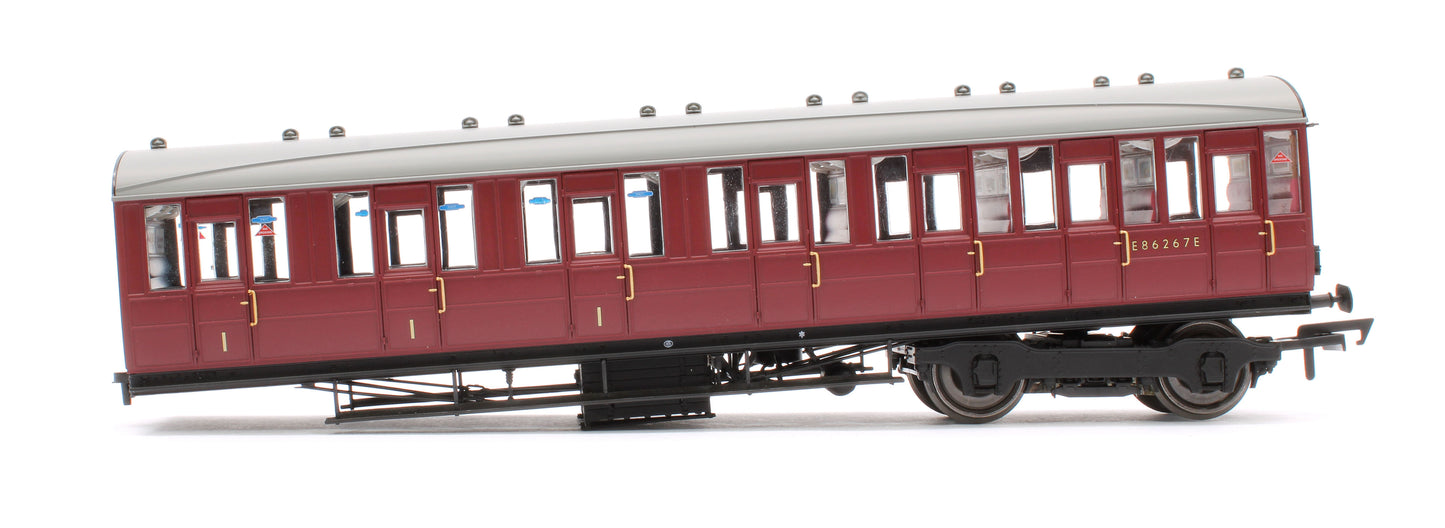Clark Railworks C2003B Quad Art Set No. 72B BR Maroon 4 Coach Pack










Product Details
| SKU | CRW-C2003B |
|---|---|
| Vendor | Clark Railworks |
| Categories | Best selling products Carriages & Coaches Clark Railworks Clark Railworks Quad Art Coach Packs Coach Packs Era 4 Era 5 Featured HO-OO In stock Items Latest Releases New products OO Gauge Carriages & Coaches OO Gauge Coach Packs OO Gauge Latest Releases OO Gauge Rolling Stock OO Gauge scale Rolling Stock |
| Scale | OO Gauge |
| Share | |
| Features |
|
Product Description
Specification
- Bogies
- Finely detailed including wheel, brake rigging and underframe details
- Brass bearings
- Separate bogie variations for centre and end bogies
- Sprung centre bogie fixing so coaches run prototypically close
- Insert for end bogies if the coupling is removed
- Electrical pickups for lighting
- Running Numbers E86267E, E86266E, E86265E & E86264E
Chassis
- Fully detailed diecast chassis
- Detailed fittings and pipework under chassis
- Sprung centre connectors for radius 2 curves and points
- Unclippable NEM pocket
- Sprung buffers on brake end coach
- Accurate and detailed paint and printing detail
- Separately fitted vacuum and battery box details
- EM/P4 on axle
- Spare brake sets for EM/P4
Body
- Detailed bodies with separate door grab rails
- Highly detailed coach ends with lit destination boards on brake ends
- Fully “low glow” interior lighting with hidden circuit boards
- Fully detailed interior with etched luggage racks and correct height seats
- Fully detailed roofs with separately fitted vents and magnetic and push fit roofs
- Magnetic switched lighting in each carriage
- Accurate and detailed paint and printing detail
A Short History of the Quad Arts
The Quad Arts were built from 1923 until 1925, with a small pause during this time to consider the electrification of the London Suburban lines. LNER directors voted against the electrification and an order for more Quad sets was placed. Due to the staggering workload on the company workshops (Darlington, Inverurie and Stratford), orders for further sets were placed with outside contractors, namely Midland Carriage & Wagon Co.
97 Sets were produced in total between the GNR, LNER & Contractors making up the distinctive fleet of Quad Art coaches.
With extensive use on the suburban lines, the Quads became a favoured work horse for moving people in busy rush hour periods. Most often, Quad Arts would run in two sets of 4 forming one set of 8, in order to move passengers from the capital quickly and efficiently.
Due to the success of the vehicles, they were the last articulated loco hauled stock seen on the UK Mainline, with their demise finally coming in April of 1966. In fact, they were so successful, it was reported two sets were fitted with Westinghouse quick service brake valves, and even reached speeds of 90 mph behind an A4!
In the later years, the Quads were hauled by a wide variety of motive power, ranging from the humble N1, N2 & N7 to locos such as A4’s, BR Class 20’s, 31’s and many more.
One of the more ‘BR famous’ sets of Quads was Set 85. Overhauled at Stratford in 1954, the set was frequently booked to work the 1758 train, Kings Cross-Welwyn Garden City, and with such was nicknamed the ‘Pottersbarbarian’.
Perhaps the most well known Quad is the set of 4 vehicles from Set 74. This has been lovingly preserved by the M&GN Society and North Norfolk Railway, where the set can be seen in service and has a permanent shed where it resides to assist it’s preservation.
The Quad Arts carried three distinctive liveries over their long life span. Firstly, they were finished in varnished teak, until BR adopted the Crimson livery for secondary stock, under which the Quads were classified. Their final guise was BR Maroon, in which they remained until they retired from their lengthy service.









